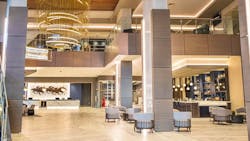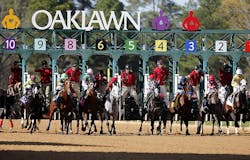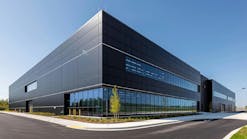Oaklawn Jockey Club expands operations with ‘thoroughbred’ security upgrade
Almost immediately after new surveillance director Dacia Schuitema arrived at the historic Oaklawn Jockey Club in Hot Springs, Ark., the owners initiated a huge expansion – increasing the facility’s casino floor and adding a hotel, event center and pool.
Every security system requires updates on a routine basis, but this unique combination of such an expansive video surveillance and security system update, upgrade and expansion demanded a combination of integration experience and expertise.
Schuitema came to Oaklawn in 2018, shortly after the racing season had finished, to find the surveillance system was nine years old – which is ancient when it comes to surveillance systems, she says.
“I immediately started looking at our options for installing a new surveillance system or trying to upgrade what we had in place,” Schuitema says. “I knew right away I would need expertise support to make the right decision and have a new solution implemented in time for the upcoming season.”
Based on her industry experience and in-depth research, Schuitema selected North American Video (NAV) as her surveillance system integrator based on their expertise with gaming and hospitality facilities, and familiarity with the vast requirements associated with gaming operations and regulations.
During the initial consultations with NAV, Schuitema determined the cost to upgrade the existing racetrack system versus replacing it were very close – and then plans for the huge expansion were confirmed.
“We were discussing updates to the existing surveillance system, and the owners announced a $100 million dollar expansion that would affect every part of the facility from the racetrack to the parking lots,” Schuitema said. “At that point I knew I had the integration partners in place to develop a new, much more comprehensive solution.”
Major Implications
Oaklawn Jockey Club was already considered one of the leading horse racing destinations in the world prior to its expansion.
Founded in 1904, the facility is one of the first racetracks in the country to feature glass-enclosed, heated grandstands and offer simulcasts of live race events.
Oaklawn Jockey Club is very active during the U.S. winter racing season from January to May with up to four race days a week attracting as many as 60,000 visitors a day spread across the track area, in the stands, betting areas and casino.
The facility expansion, with numerous new visitor amenities and attractions, was intended to further solidify Oaklawn Jockey Club’s position as a premier race facility.
Schuitema’s team is responsible for video surveillance of the casino and all gaming operations, as well as facility video security for the hotel, horse stables and barns, event facilities and parking lots.
They’re also responsible for monitoring all activities on the field as a backup for operational questions or investigations and capturing and recording video of the tote board for all the wagering done on the track.
Aware that such an expansion in a premier racing, gaming and event facility would have major safety and security implications, Schuitema was chosen to lead the upgrade due to having several years of experience in the security industry, her last position being at a hotel/casino property undergoing an expansion and update program.
“I arrived at my last position expecting to do a rip-and-replace on the surveillance system,” Schuitema said. “However, at the same time, they were building an eight-story hotel, remodeling the gaming floor and adding a new nightclub and conference rooms. So, I had to quickly expand our efforts to handle all those changes at the same time. I was there for four years – and we were under construction for three and half of those years.”
“The situation at Oaklawn was a bigger version of that experience – expanding the gaming floor, a new hotel and event center – but with the additional complexity and responsibility for an entire racetrack, the associated stables and other operational areas. Welcome back to construction, I thought – this is becoming my theme,” continued Schuitema.
Getting on the Same Page
Some early decisions were critical to overall project success. For example, Schuitema knew she needed to deploy two separate systems: a surveillance system with very limited access to cover all gaming operations, and a video security system to cover the balance of the grounds that would be accessible by operations personnel and horse owners who wanted to check on their horses.
Schuitema says the solution developed by NAV included implementing multiple systems for gaming surveillance and general facility security.
“We have a closed system for the controlled areas that doesn’t have any connection to the public internet, thereby eliminating the chances of infiltration, data breach or anything to do with gaming security,” she says. “We implemented a more open system with a web-based solution for the stable and barn areas that could be securely managed to provide remote viewing access for approved users.”
Another important decision was selection of the primary camera manufacturer. Schuitema had a vision for the system, along with demanding specifications, to meet the scope and complexity of her team’s responsibilities.
“I planned to use a mix of the products proposed by NAV but took a particular interest in the primary camera manufacturer, because of the importance of certain specs,” she said. Dallmeier provided a test camera that Schuitema’s team worked with for about two weeks before meeting with the company again – “and once we had worked with it there was no way we were going to give it back,” she added.
Selling the Need
Schuitema worked closely with NAV, her IT department and all related facility departments to ensure that the planned system would meet the entire organization’s needs. She argued successfully with management that her planned budget, which amounted to about 1% of the cost of the facility improvements, was justified to deliver the safety and security capabilities they needed.
“I felt totally supported by the owners and management throughout this process,” she says. “They gave me everything I needed, much to the surprise of some of the other departments. I was successful because I could prove the need, and once it was explained it was easy for the owners to see, evaluate and approve the system plan.”
Schuitema notes Arkansas has some unique aspects to regulations, including have state regulators on the property often, so the facility notified regulators early in the process.
“They are always on call and will come in if we need them,” she says. “When I was approved for the project, I went and talked with our state rep here. I gave her a rundown of everything that we were doing with the equipment we were putting in, and the name of the system, and they said, ‘OK, Go’. We work closely with them, and they are very easy to work with.”
Staying on Schedule
Large projects take time to roll out, and the Oaklawn Jockey Club system was no exception. Schuitema carefully managed the new systems implementation in phases, while adjusting as necessary to unexpected events. She says NAV kept her informed of delivery status and any delays.
The Dallmeier cameras come from Germany, and a 12-week lead time is normal. “I had deliveries sitting in customs for almost eight weeks at the height of COVID, so that delayed us a bit. But NAV helped to make up the time for the setback and we remained largely on schedule despite widespread supply chain issues,” Schuitema says.
She also noted that NAV’s process to install the new system while the old system was still running resulted in minimal disruption to operations.
“There's no doubt that we are a lot busier these days. I've expanded my department, added operators and completely reconfigured our surveillance room. I have two full-time techs on staff all the time,” she says.
“They're regular full-time employees, and they worked right alongside the NAV folks to become as familiar as possible with the system. During the project, if we had a technical task indoors that was not related to the expansion project, they could go and do their thing while NAV stayed on the expansion and putting in the new system.
“It was actually a smooth transition from the old system to the new. We had NAV on site, and they helped us through. Our IT department helped us as well, and we have a great working relationship with them and appreciate their expertise and support.”
Schuitema says her team is happy with the new system, which includes 1,400 cameras providing staff with comprehensive coverage of the facility.
Measuring the Impact
Oaklawn went from nine cameras in the parking lots to 28, including some advanced panoramic technology from Dallmeier. Security staff can monitor a parking lot across the street with a camera mounted on top of their building, streaming back images in such detail that the words on a person’s T-shirt standing at the back of the lot – about 500 yards away – can be read.
“We don’t need that capability every day,” Schuitema says, “but we have definitely had situations where that capability was needed, and that improved performance is echoed throughout the new systems.”
The standalone systems, such as one in the stable areas to watch for tampering and unauthorized access, “have been hugely beneficial for us to ensure the safety of the owners and their horses,” says Schuitema. “During a race weekend we can have fifteen hundred horses there, with all the jockeys, trainers, grooms and others that make it all work. That area is like a small city with thousands of people.”
Schuitema adds the partners that were chosen and the approach to executive the project all worked well. She notes NAV’s owners, project managers and technicians were very accessible.
“Finding the right integrator to support you for the long run is one of the biggest factors for success in these types of projects,” Schuitema says.



